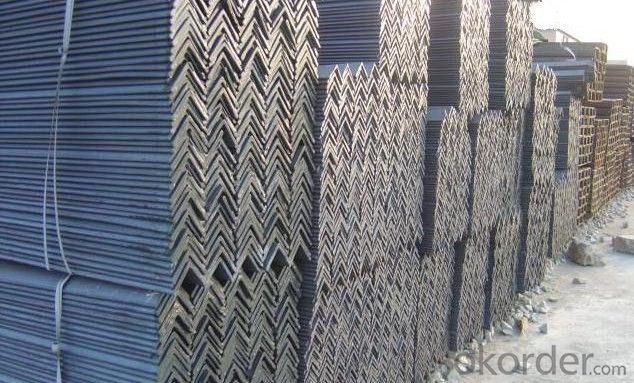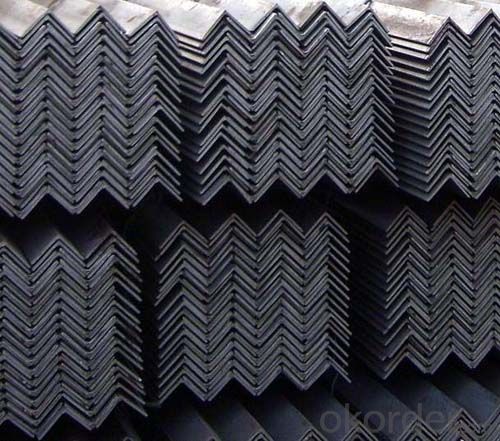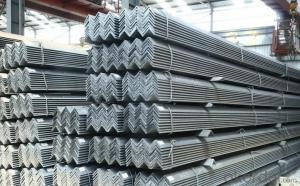Steel Equal Angle with Good Quality 120*120*8.0-10.0mm
- Loading Port:
- Tianjin
- Payment Terms:
- TT OR LC
- Min Order Qty:
- 50 m.t
- Supply Capability:
- 15000 m.t/month
OKorder Service Pledge
OKorder Financial Service
You Might Also Like
Item specifice
Product Description:
Specifications of Steel Equal Angle with Good Quality 120*120*8.0-10.0mm:
1. Invoicing on theoretical weight or actual weight as customer request
2. Length: 6m, 9m, 12m as following table
3. Sizes

| Size(mm) | Mass(Kg/m) | Size(mm) | Mass(Kg/m) |
| 120*120*8.0 | 14.57 | 120*120*10.0 | 18.055 |
Payment terms:
1).100% irrevocable L/C at sight.
2).30% T/T prepaid and the balance against the copy of B/L.
3).30% T/T prepaid and the balance against L/C
Material details:
Grade | Element (%) | ||||
C | Mn | S | P | Si | |
Q235 | 0.12—0.20 | 0.3—0.7 | ≤0.045 | ≤0.045 | ≤0.3 |
Usage & Applications of Steel Equal Angle with Good Quality 120*120*8.0-10.0mm:
According to the needs of different structures, Angle can compose to different force support component, and also can be the connections between components. It is widely used in various building structures and engineering structures such as roof beams, bridges, transmission towers, hoisting machinery and transport machinery, ships, industrial furnaces, reaction tower, container frame and warehouse etc.
Packaging & Delivery of Steel Equal Angle with Good Quality 120*120*8.0-10.0mm:
1. Packing: it is nude packed in bundles by steel wire rod
2. Bundle weight: not more than 3.5MT for bulk vessel; less than 3 MT for container load
3. Marks:
Color marking: There will be color marking on both end of the bundle for the cargo delivered by bulk vessel. That makes it easily to distinguish at the destination port.
Tag mark: there will be tag mark tied up on the bundles. The information usually including supplier logo and name, product name, made in China, shipping marks and other information request by the customer.
If loading by container the marking is not needed, but we will prepare it as customer request.
Production flow of Steel Equal Angle with Good Quality 120*120*8.0-10.0mm:
Material prepare (billet) —heat up—rough rolling—precision rolling—cooling—packing—storage and transportation
FAQ:
Q1: Why buy Materials & Equipment from OKorder.com?
A1: All products offered byOKorder.com are carefully selected from China's most reliable manufacturing enterprises. Through its ISO certifications, OKorder.com adheres to the highest standards and a commitment to supply chain safety and customer satisfaction.
Q2: How do we guarantee the quality of our products?
A2: We have established an advanced quality management system which conducts strict quality tests at every step, from raw materials to the final product. At the same time, we provide extensive follow-up service assurances as required.
Q3: How soon can we receive the product after purchase?
A3: Within three days of placing an order, we will begin production. The specific shipping date is dependent upon international and government factors, but is typically 1 to 2 months.
Q4: How many tons can be loaded into one 20ft container?
A4: Around 23—25tons
Images of Steel Equal Angle with Good Quality 120*120*8.0-10.0mm:


- Q:What is the standard size of steel angles?
- Steel angles come in a range of sizes that vary depending on the region and industry standards. Generally, they are available in equal and unequal leg lengths, with the equal leg angles typically sized between 20mm and 200mm. The thickness of the angle can also vary, typically falling between 3mm and 20mm. However, it is crucial to understand that these measurements may differ based on the specific application or project requirements. To determine the correct size of steel angles for a particular project, it is recommended to consult industry standards or manufacturers.
- Q:Can steel angles be used in mining or quarrying machinery?
- Yes, steel angles can be used in mining or quarrying machinery. Steel angles provide structural support and reinforcement to various components of machinery used in these industries. They are commonly used in the construction of frames, supports, and brackets for equipment such as crushers, conveyors, and screens. The high strength and durability of steel angles make them suitable for withstanding the heavy loads, vibrations, and harsh operating conditions typically encountered in mining or quarrying operations. Additionally, steel angles can be easily fabricated and welded to meet specific design requirements, making them a versatile choice for machinery applications in these industries.
- Q:What is the typical thickness of the base of a steel angle?
- The typical thickness of the base of a steel angle can vary depending on the specific application and requirements. However, in general, the base thickness of a steel angle commonly ranges from 1/8 inch to 3/8 inch. It is important to note that this range is not exhaustive and there may be cases where the base thickness falls outside of these parameters. Factors such as the size, load-bearing capacity, and intended use of the steel angle will influence the base thickness required for a particular project or structure. Therefore, it is crucial to consult engineering specifications or professional guidance to determine the appropriate base thickness for a steel angle in a specific application.
- Q:Can steel angles be used in automotive applications?
- Indeed, automotive applications can make use of steel angles. The automotive industry frequently employs steel angles for a multitude of purposes, including frames, chassis, supports, brackets, and reinforcements. The reason behind this preference lies in the fact that steel angles possess exceptional strength, durability, and resistance to impact and vibrations. Consequently, they prove suitable for enduring the challenging conditions and demanding loads that arise within automotive applications. Furthermore, the ease with which steel angles can be welded or bolted together grants designers and constructors flexibility when designing and constructing automotive components. On the whole, due to their strength, versatility, and capacity to withstand the industry's rigorous demands, steel angles represent a dependable and cost-effective choice for automotive applications.
- Q:How do you prevent steel angles from bending under load?
- In order to prevent steel angles from bending under load, several important measures can be taken: 1. Choose the appropriate size and material for the angle: It is important to select a steel angle that is of sufficient size and material strength to withstand the expected load. Seeking guidance from structural engineering guidelines or professionals can help determine the correct dimensions and material composition for the specific application. 2. Strengthen the angle: Enhance the strength of the steel angle by adding additional support or reinforcement. This can be achieved through techniques such as welding extra plates to the angle, utilizing gussets or stiffeners, or incorporating diagonal bracing. These reinforcements help distribute the load more evenly and reduce the likelihood of bending. 3. Increase the thickness: If possible, increasing the thickness of the steel angle can improve its ability to bear loads. A thicker angle will have greater resistance to bending and deformation under load. 4. Ensure proper installation: It is crucial to install the steel angles correctly and securely in order to maximize their resistance to bending. This involves using appropriate fasteners, such as bolts or welds, and following proper installation techniques. 5. Avoid excessive loads: Preventing steel angles from bending under load also requires careful consideration of the maximum load they will encounter. It is important to avoid overloading the angles beyond their design capacity, as this significantly increases the risk of bending or failure. 6. Regular inspections: Regularly inspect the steel angles for any signs of bending, cracking, or deformation. Prompt identification of potential issues allows for timely maintenance or reinforcement, preventing further damage or accidents. To ensure the proper design and implementation of these measures, it is crucial to consult with a qualified structural engineer or professional experienced in steel fabrication.
- Q:What does L50*4 angle mean in CAD?
- Angle called angle, the steel strip is perpendicular to each other on both sides into the corner. There are equal angles and unequal angles. The two sides of an equal angle steel are equal in width. The specifications are expressed in millimeters of edge width * edge width * edge thickness. Such as "30 x 30 x 3", that is 30 mm width equal angle, edge thickness of 3 mm.
- Q:What are the standard sizes for steel angles?
- The standard sizes for steel angles vary depending on the manufacturer and the specific requirements of the project. However, some commonly available sizes for steel angles include 1/2 inch, 3/4 inch, 1 inch, 1-1/4 inch, 1-1/2 inch, and 2 inches. These sizes refer to the measurement of the sides of the angle.
- Q:Can steel angles be cut to custom lengths?
- Indeed, custom lengths can be achieved when cutting steel angles. Steel angles, also referred to as angle irons, are multifunctional structural elements widely utilized in both construction and manufacturing. Although they are obtainable in different standard sizes, they can also be tailored to meet specific length specifications. This can be accomplished by utilizing cutting tools like saws or shears to trim the steel angle to the desired measurement. The capability to customize steel angles to unique lengths renders them apt for a diverse array of applications, as they can be adjusted to suit precise design necessities.
- Q:What are the common applications of steel angles?
- Steel angles are widely used in various applications due to their versatility and strength. Some common applications of steel angles include: 1. Structural support: Steel angles are commonly used as structural elements in buildings and bridges. They provide strength and stability to the structure and are often used as beams, columns, and braces. 2. Construction: Steel angles are used in construction projects to create frames, supports, and reinforcements. They can be used to create corners in walls, support roof trusses, and provide additional strength to concrete structures. 3. Machinery and equipment: Steel angles are utilized in the manufacturing of machinery and equipment. They are often used as brackets, frames, and supports for various components. Steel angles provide stability and structural integrity to these machines. 4. Industrial shelving and racks: Steel angles are commonly used to construct industrial shelving units and racks. They provide a sturdy and reliable structure to store heavy items and maximize storage space. 5. Agricultural equipment: Steel angles are used in the fabrication of agricultural machinery and equipment. They are often used to create frames, supports, and brackets for farm implements such as plows, cultivators, and harvesters. 6. Fencing and barriers: Steel angles are utilized in the construction of fences, barriers, and handrails. They provide a strong and durable structure that can withstand harsh weather conditions and provide security. 7. Transportation: Steel angles are used in the construction of vehicles and transportation equipment. They can be found in truck beds, trailers, and railings. Steel angles offer strength and stability to these structures, ensuring safe transportation of goods and passengers. 8. Decorative and architectural applications: Steel angles are often used in decorative and architectural applications. They can be incorporated into building facades, staircases, and ornamental metalwork. Steel angles provide a modern and sleek look while also offering structural support. Overall, steel angles have a wide range of applications in various industries due to their strength, versatility, and durability.
- Q:What are the different corrosion protection methods for steel angles?
- There are several corrosion protection methods for steel angles, including galvanization, powder coating, paint coating, and epoxy coating.
1. Manufacturer Overview |
|
|---|---|
| Location | |
| Year Established | |
| Annual Output Value | |
| Main Markets | |
| Company Certifications | |
2. Manufacturer Certificates |
|
|---|---|
| a) Certification Name | |
| Range | |
| Reference | |
| Validity Period | |
3. Manufacturer Capability |
|
|---|---|
| a)Trade Capacity | |
| Nearest Port | |
| Export Percentage | |
| No.of Employees in Trade Department | |
| Language Spoken: | |
| b)Factory Information | |
| Factory Size: | |
| No. of Production Lines | |
| Contract Manufacturing | |
| Product Price Range | |
Send your message to us
Steel Equal Angle with Good Quality 120*120*8.0-10.0mm
- Loading Port:
- Tianjin
- Payment Terms:
- TT OR LC
- Min Order Qty:
- 50 m.t
- Supply Capability:
- 15000 m.t/month
OKorder Service Pledge
OKorder Financial Service
Similar products
New products
Hot products
Related keywords




























